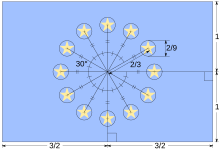European Union symbols
The symbols of the European Union act as emblems and national symbols of the EU . These include the European flag , the European anthem , Europe Day , the European motto , and the euro currency (with its currency symbol € ).
The symbols

The flag, anthem and Europe Day had already been introduced by the Council of Europe before the European Union , but only became known to a broad population after the heads of state and government of the European Communities (EC) at the European Council of Milan in 1985 on the recommendation of the Committee for the “Europe of the Citizens” had also adopted for the EC. In Article I-8 of the European Constitutional Treaty of 2004, the symbols were also mentioned as official symbols of the Union for the first time. However, this met with criticism, especially in Great Britain , as it was seen as a step towards a pan-European “superstate”. After the failure of the constitution, the symbols are no longer included in the Lisbon Treaty ; however, they are still used by the EU.
European flag
The European flag shows a wreath of twelve golden five-pointed stars on an azure background. Their number does not symbolize the number of member states, but is intended to express “perfection, completeness and unity”. The flag has been used as an official emblem by the Council of Europe since 1955 and by the EC since 1985.
European anthem
The European anthem is the instrumental version of the last movement of the 9th Symphony by Ludwig van Beethoven, arranged by Herbert von Karajan . In 1972 the melody was adopted as an anthem by the Council of Europe and in 1985 by the EC. It appears alongside the national anthems of the member states and symbolizes the values that everyone shares and unity in diversity.
Europe day
With events and advertising, Europe Day is intended to commemorate the Schuman Plan of May 9, 1950, which is now considered the cornerstone of European unification. At the Milan Council in 1985 it was decided to commemorate this event annually on Europe Day of the European Union, on which numerous events and festivities have been taking place since 1986. In addition, the Council of Europe has been celebrating its own Europe Day since 1964: However, this is four days earlier and commemorates the founding of this institution on May 5, 1949.
European motto
The European motto is the motto:
"United in diversity."
It is intended to express the common but nationally different European identity. It was selected in 2000 in a competition among students from the then 15 member states. In the 24 official languages of the European Union it is:
| Bulgarian - Единни в многообразието | French - Unie dans la diversité | Lithuanian - Vienybė įvairialypiškume | Swedish - Förenade i mångfalden |
| Danish - Forenet i mangfoldighed | Greek - Ενωμένοι στην πολυμορφία | Maltese - Magħqudin fid-diversità | Slovak - Zjedotení v rozmanitosti |
| German - United in diversity | Irish - Aontaithe d'ainneoin na héagsúlachta | Dutch - In verscheidenheid verenigd | Slovenian - Združeni v raznolikosti |
| English - United in diversity | Italian - Uniti nella diversità | Polish - Jedność w różnorodności | Spanish - Unida en la diversidad |
| Estonian - Ühtsus erinevuses | Croatian - Ujedinjena u raznolikosti | Portuguese - Unidos na diversidade | Czech - Jednotná v rozmanitosti |
| Finnish - Erilaisuudessaan yhdistynyt / Moninaisuudessaan yhtenäinen | Latvian - Vienotība dažādībā | Romanian - Unitate în diversitate | Hungarian - Egység a sokféleségben |
Euro
The euro is the official currency of the European Union, which is used in all documents and guidelines. The euro is also the most widely used currency in the European Union, with 19 of its member states having it as their currency within the euro zone in 2015 .



